engine coolant FORD TRANSIT 2021 Owners Manual
[x] Cancel search | Manufacturer: FORD, Model Year: 2021, Model line: TRANSIT, Model: FORD TRANSIT 2021Pages: 509, PDF Size: 8.21 MB
Page 9 of 509

Under Hood Overview - 3.5L Duratec
.......................................................................280
Under Hood Overview - 3.5L Ecoboost™ ........................................................................\
.
281
Engine Oil Dipstick - 3.5L Duratec ........
282
Engine Oil Dipstick - 3.5L Ecoboost™ ........................................................................\
282
Engine Oil Check .........................................
282
Changing the Engine Oil and Oil Filter ........................................................................\
283
Oil Change Indicator Reset .....................
284
Changing the Engine Air Filter ...............
284
Engine Cooling Fan ....................................
285
Engine Coolant Check ..............................
285
Automatic Transmission Fluid Check ........................................................................\
289
Brake Fluid Check ......................................
290
Changing the 12V Battery ........................
290
Adjusting the Headlamps ........................
293
Washer Fluid Check ...................................
294
Fuel Filter .......................................................
294
Checking the Wiper Blades ....................
294
Changing the Front Wiper Blades ........
295
Removing a Headlamp .............................
295
Changing a Bulb .........................................
296
Drive Belt Routing - Vehicles With: Dual Generators .................................................
301
Drive Belt Routing - Vehicles With: Single Generator ...................................................
301
Vehicle Care
Cleaning Products ......................................
302
Cleaning the Exterior .................................
303
Waxing ...........................................................
304
Cleaning the Engine ..................................
304
Cleaning the Windows and Wiper Blades ........................................................................\
305
Cleaning the Interior ..................................
305
Cleaning the Instrument Panel and Instrument Cluster Lens ......................
307
Repairing Minor Paint Damage .............
308Cleaning the Wheels
.................................
308
Vehicle Storage ...........................................
308
Body Styling Kits ..........................................
310
Wheels and Tires
General Information ....................................
311
Tire Sealant and Inflator Kit .....................
312
Tire Care ..........................................................
315
Using Winter Tires ......................................
332
Using Snow Chains ....................................
333
Tire Pressure Monitoring System ..........
334
Changing a Road Wheel ..........................
339
Lug Nuts .........................................................
350
Capacities and Specifications
Engine Specifications - 3.5L Duratec ........................................................................\
352
Engine Specifications - 3.5L Ecoboost™ ........................................................................\
353
Motorcraft Parts - 3.5L Duratec ............
354
Motorcraft Parts - 3.5L Ecoboost™ .....
355
Vehicle Identification Number ...............
356
Transmission Code Designation ............
357
Capacities and Specifications - 3.5L Duratec .......................................................
358
Capacities and Specifications - 3.5L Ecoboost™ ...............................................
363
Bulb Specification Chart .........................
369
Connected Vehicle
What Is a Connected Vehicle ...................
371
Connected Vehicle Requirements .........
371
Connected Vehicle Limitations ...............
371
Connecting the Vehicle to a Mobile Network .......................................................
371
Connecting the Vehicle to a Wi-Fi Network ......................................................
372
Connected Vehicle – Troubleshooting - Vehicles With: Modem ..........................
372
6
2021 Transit (TTH) Canada/United States of America, MK3J 19A321 AA enUSA, Edition date: 202010, Second-Printing Table of Contents
Page 13 of 509
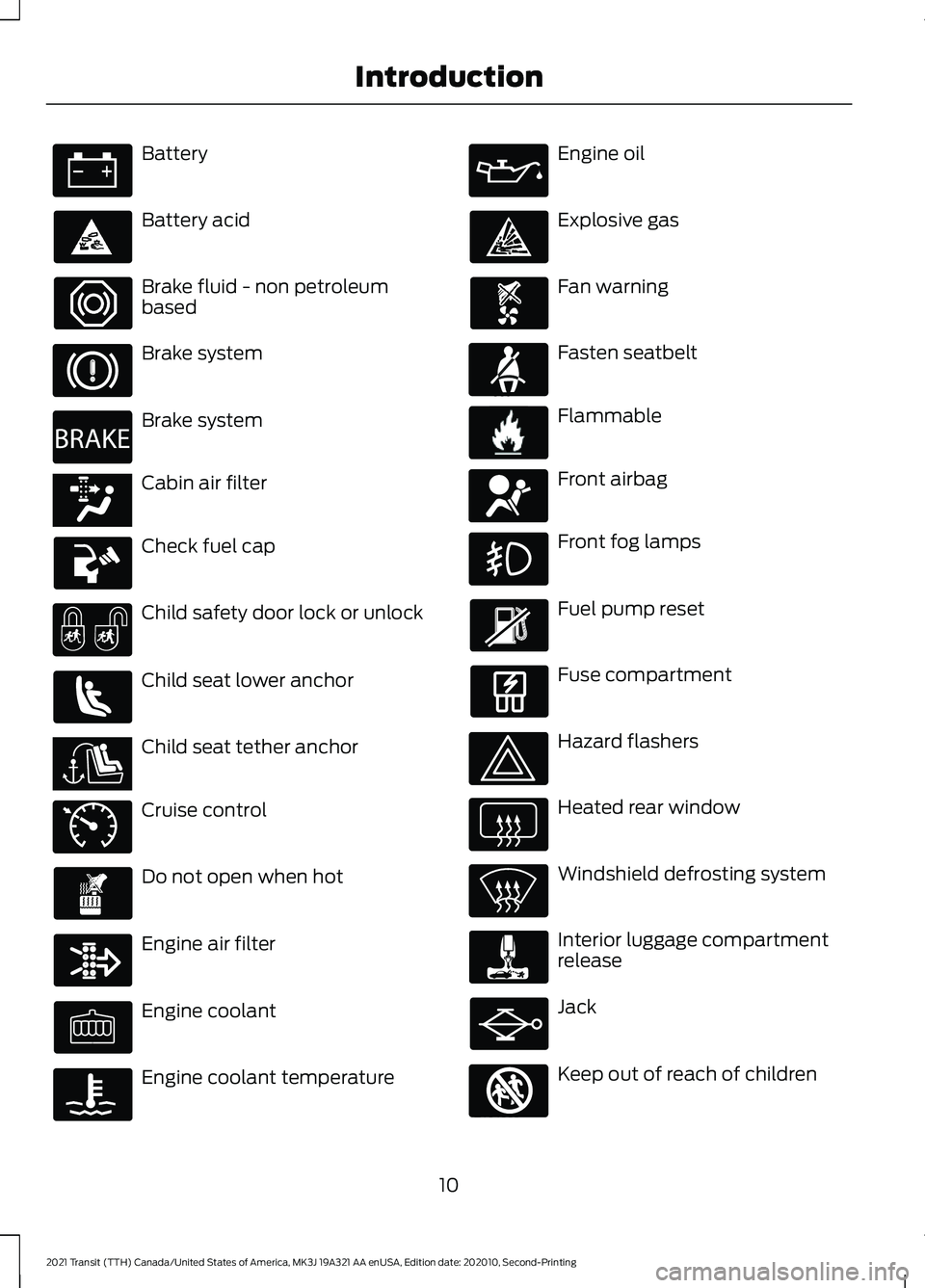
Battery
Battery acid
Brake fluid - non petroleum
based
Brake system
Brake system
Cabin air filter
Check fuel cap
Child safety door lock or unlock
Child seat lower anchor
Child seat tether anchor
Cruise control
Do not open when hot
Engine air filter
Engine coolant
Engine coolant temperature Engine oil
Explosive gas
Fan warning
Fasten seatbelt
Flammable
Front airbag
Front fog lamps
Fuel pump reset
Fuse compartment
Hazard flashers
Heated rear window
Windshield defrosting system
Interior luggage compartment
release
Jack
Keep out of reach of children
10
2021 Transit (TTH) Canada/United States of America, MK3J 19A321 AA enUSA, Edition date: 202010, Second-Printing Introduction E270480 E139223 E141128 E71340 E71880 E231160 E67017 E161353
Page 113 of 509

GAUGES
Instrument Cluster
Tachometer.
A
Information display.
B
Speedometer.
C
Fuel gauge.
D
Automatic transmission position indicators.
E
Engine coolant temperature gauge.
F
Tachometer
Shows the engine speed.
Information Display
Shows the following information:
• Odometer.
• Trip computer.
• MyView information.
• Driver assistance information.
• Navigation information. •
Audio information.
• Phone information.
• Vehicle and system settings.
• Outside air temperature.
• Shift indicators.
Odometer
Records the total distance traveled by your
vehicle.
110
2021 Transit (TTH) Canada/United States of America, MK3J 19A321 AA enUSA, Edition date: 202010, Second-Printing Instrument ClusterABC
EDFE337945
Page 114 of 509
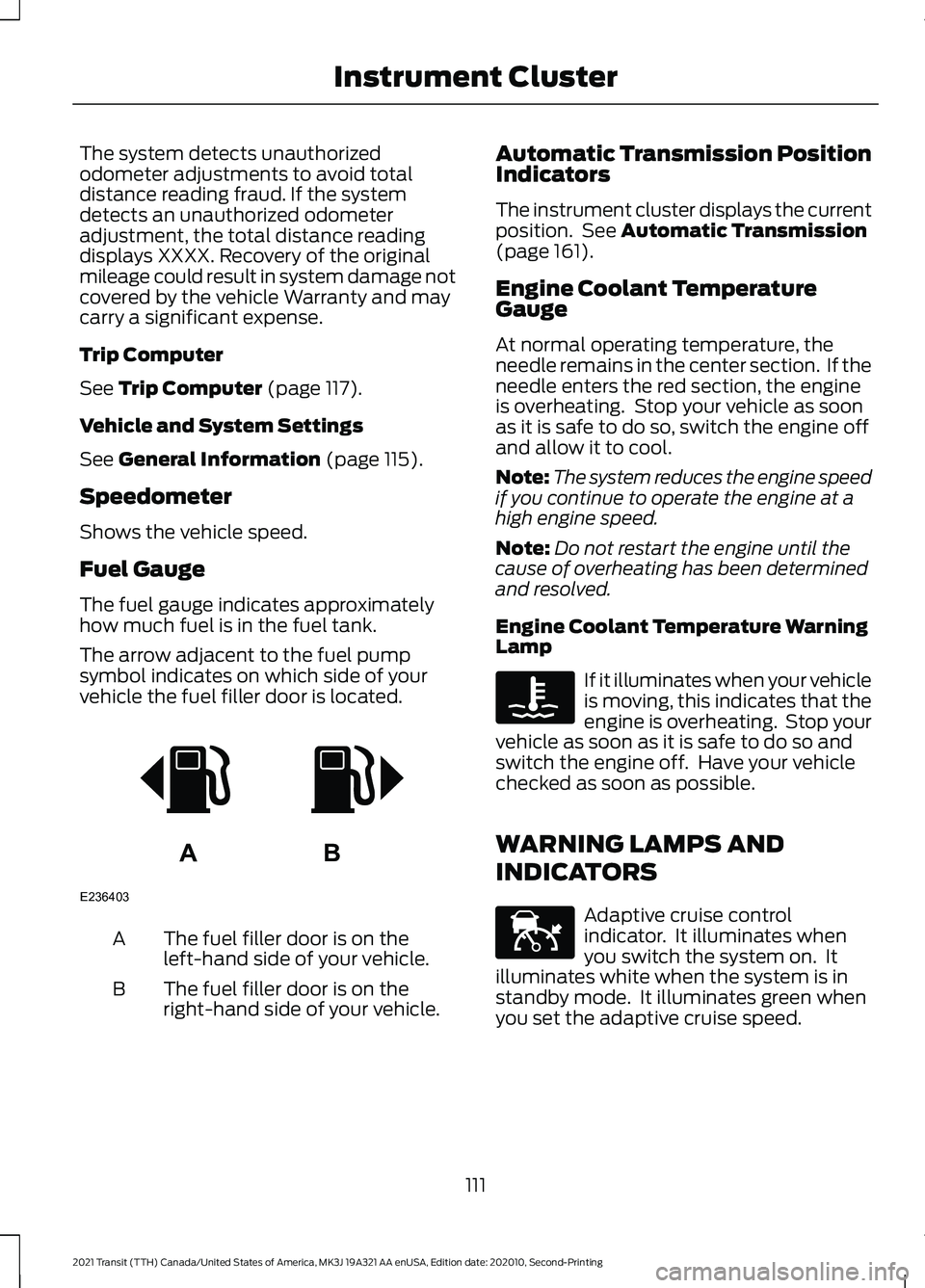
The system detects unauthorized
odometer adjustments to avoid total
distance reading fraud. If the system
detects an unauthorized odometer
adjustment, the total distance reading
displays XXXX. Recovery of the original
mileage could result in system damage not
covered by the vehicle Warranty and may
carry a significant expense.
Trip Computer
See Trip Computer (page 117).
Vehicle and System Settings
See
General Information (page 115).
Speedometer
Shows the vehicle speed.
Fuel Gauge
The fuel gauge indicates approximately
how much fuel is in the fuel tank.
The arrow adjacent to the fuel pump
symbol indicates on which side of your
vehicle the fuel filler door is located. The fuel filler door is on the
left-hand side of your vehicle.
A
The fuel filler door is on the
right-hand side of your vehicle.
B Automatic Transmission Position
Indicators
The instrument cluster displays the current
position. See
Automatic Transmission
(page 161).
Engine Coolant Temperature
Gauge
At normal operating temperature, the
needle remains in the center section. If the
needle enters the red section, the engine
is overheating. Stop your vehicle as soon
as it is safe to do so, switch the engine off
and allow it to cool.
Note: The system reduces the engine speed
if you continue to operate the engine at a
high engine speed.
Note: Do not restart the engine until the
cause of overheating has been determined
and resolved.
Engine Coolant Temperature Warning
Lamp If it illuminates when your vehicle
is moving, this indicates that the
engine is overheating. Stop your
vehicle as soon as it is safe to do so and
switch the engine off. Have your vehicle
checked as soon as possible.
WARNING LAMPS AND
INDICATORS Adaptive cruise control
indicator. It illuminates when
you switch the system on. It
illuminates white when the system is in
standby mode. It illuminates green when
you set the adaptive cruise speed.
111
2021 Transit (TTH) Canada/United States of America, MK3J 19A321 AA enUSA, Edition date: 202010, Second-Printing Instrument ClusterAB
E236403 E144524
Page 116 of 509

Engine coolant temperature
warning lamp. If it illuminates
when your vehicle is moving, this
indicates that the engine is overheating.
Stop your vehicle as soon as it is safe to
do so and switch the engine off. Have your
vehicle checked as soon as possible. Engine oil pressure warning
lamp. It illuminates when you
switch the ignition on. If it
illuminates when the engine is running this
indicates a malfunction. Stop your vehicle
as soon as it is safe to do so and switch the
engine off. Check the engine oil level. If
the oil level is sufficient, this indicates a
system malfunction. Have your vehicle
checked as soon as possible. Engine warning lamps. If both
lamps illuminate when the
engine is running, stop your
vehicle as soon as it is safe to do
so. Continuing to drive your
vehicle may cause reduced
power or the engine to stop. Switch the
ignition off and attempt to restart the
engine. Have your vehicle checked as soon
as possible. Fasten seatbelt warning lamp. It
illuminates until you fasten your
seatbelt.
Front fog lamp indicator. It
illuminates when you switch the
front fog lamps on.
Hazard flasher indicator. It
flashes when you switch the
hazard flashers on.
High beam headlamp indicator.
It illuminates when you switch
the high beam headlamps on. Ignition warning lamp. It
illuminates when you switch the
ignition on. If it illuminates when
the engine is running this indicates a
malfunction. Have your vehicle checked
as soon as possible. Lamps on indicator. It
illuminates when you switch the
low beam headlamps or the side
and rear lamps on. Lane keeping aid indicator. It
illuminates in the information
display when you switch the
system on and Aid Mode or Alert and Aid
Mode are selected. Lane keeping alert indicator. It
illuminates in the information
display when you switch the
system on and Alert Mode is selected. Lane keeping system warning
lamp. It could illuminate when
you switch the system off. If it
illuminates when you are driving, this
indicates a malfunction. Have your vehicle
checked as soon as possible. Low fuel level warning lamp. If
it illuminates when you are
driving, refuel as soon as
possible. Malfunction indicator lamp. If it
illuminates when the engine is
running this indicates a
malfunction. If it flashes, engine misfire
may be occurring. Increased exhaust gas
temperatures could damage the diesel
particulate filter or other vehicle
components. Avoid heavy acceleration
and deceleration and have your vehicle
checked as soon as possible. Mud/Ruts mode indicator. It
illuminates when the drive mode
is selected.
113
2021 Transit (TTH) Canada/United States of America, MK3J 19A321 AA enUSA, Edition date: 202010, Second-Printing Instrument Cluster E71880 E251020 E296606
Page 150 of 509

The heater acts as a starting aid by
warming the engine coolant. This allows
the climate control system to respond
quickly. The equipment includes a heater
element, installed in the engine block and
a wire harness. You can connect the
system to a grounded 120-volt AC
electrical source.
We recommend that you do the following
for a safe and correct operation:
•
Use a 16-gauge outdoor extension cord
that is product certified by
Underwriter ’s Laboratory (UL) or
Canadian Standards Association
(CSA). This extension cord must be
suitable for use outdoors, in cold
temperatures, and be clearly marked
Suitable for Use with Outdoor
Appliances. Do not use an indoor
extension cord outdoors. This could
result in an electric shock or become a
fire hazard.
• Use as short an extension cord as
possible.
• Do not use multiple extension cords.
• Make sure that when in operation, the
extension cord plug and heater cord
plug connections are free and clear of
water. This could cause an electric
shock or fire.
• If the block heater cord is under the
hood, Do Not remove the wiring from
its original location. Do Not close the
hood on the extension wiring.
• Make sure your vehicle is parked in a
clean area, clear of combustibles.
• Make sure the heater, heater cord and
extension cord are firmly connected.
• Check for heat anywhere in the
electrical hookup once the system has
been operating for approximately 30
minutes. •
Make sure the system is unplugged and
properly stowed before starting and
driving your vehicle. Make sure the
protective cover seals the prongs of the
block heater cord plug when not in use.
• Make sure the heater system is
checked for proper operation before
winter.
Using the Engine Block Heater
Make sure the receptacle terminals are
clean and dry prior to use. Clean them with
a dry cloth if necessary.
The heater uses 0.4 to 1.0 kilowatt-hours
of energy per hour of use. The system does
not have a thermostat. It achieves
maximum temperature after
approximately three hours of operation.
Using the heater longer than three hours
does not improve system performance and
unnecessarily uses electricity.
147
2021 Transit (TTH) Canada/United States of America, MK3J 19A321 AA enUSA, Edition date: 202010, Second-Printing Starting and Stopping the Engine
Page 249 of 509
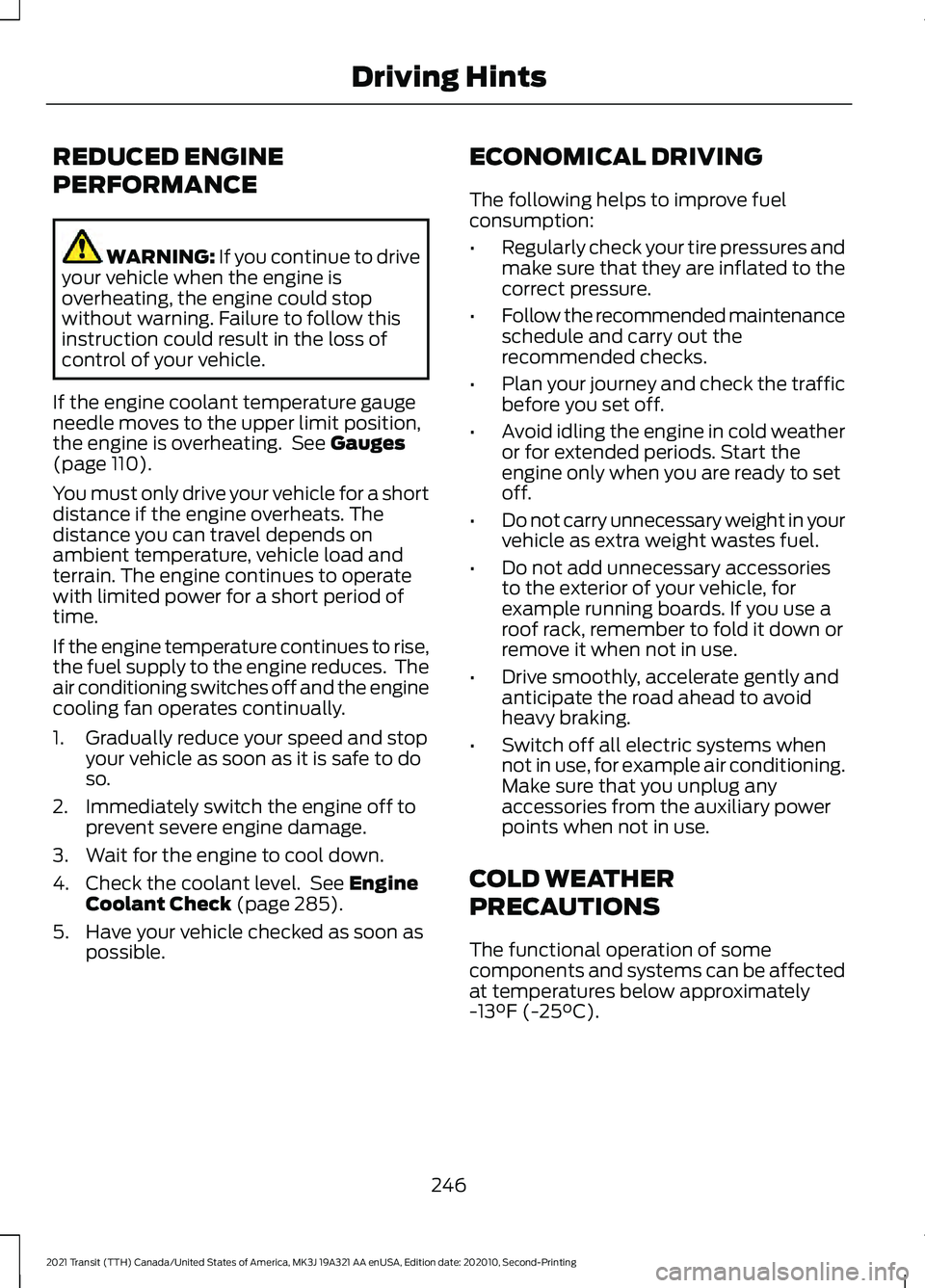
REDUCED ENGINE
PERFORMANCE
WARNING: If you continue to drive
your vehicle when the engine is
overheating, the engine could stop
without warning. Failure to follow this
instruction could result in the loss of
control of your vehicle.
If the engine coolant temperature gauge
needle moves to the upper limit position,
the engine is overheating. See Gauges
(page 110).
You must only drive your vehicle for a short
distance if the engine overheats. The
distance you can travel depends on
ambient temperature, vehicle load and
terrain. The engine continues to operate
with limited power for a short period of
time.
If the engine temperature continues to rise,
the fuel supply to the engine reduces. The
air conditioning switches off and the engine
cooling fan operates continually.
1. Gradually reduce your speed and stop your vehicle as soon as it is safe to do
so.
2. Immediately switch the engine off to prevent severe engine damage.
3. Wait for the engine to cool down.
4. Check the coolant level. See
Engine
Coolant Check (page 285).
5. Have your vehicle checked as soon as possible. ECONOMICAL DRIVING
The following helps to improve fuel
consumption:
•
Regularly check your tire pressures and
make sure that they are inflated to the
correct pressure.
• Follow the recommended maintenance
schedule and carry out the
recommended checks.
• Plan your journey and check the traffic
before you set off.
• Avoid idling the engine in cold weather
or for extended periods. Start the
engine only when you are ready to set
off.
• Do not carry unnecessary weight in your
vehicle as extra weight wastes fuel.
• Do not add unnecessary accessories
to the exterior of your vehicle, for
example running boards. If you use a
roof rack, remember to fold it down or
remove it when not in use.
• Drive smoothly, accelerate gently and
anticipate the road ahead to avoid
heavy braking.
• Switch off all electric systems when
not in use, for example air conditioning.
Make sure that you unplug any
accessories from the auxiliary power
points when not in use.
COLD WEATHER
PRECAUTIONS
The functional operation of some
components and systems can be affected
at temperatures below approximately
-13°F (-25°C)
.
246
2021 Transit (TTH) Canada/United States of America, MK3J 19A321 AA enUSA, Edition date: 202010, Second-Printing Driving Hints
Page 269 of 509
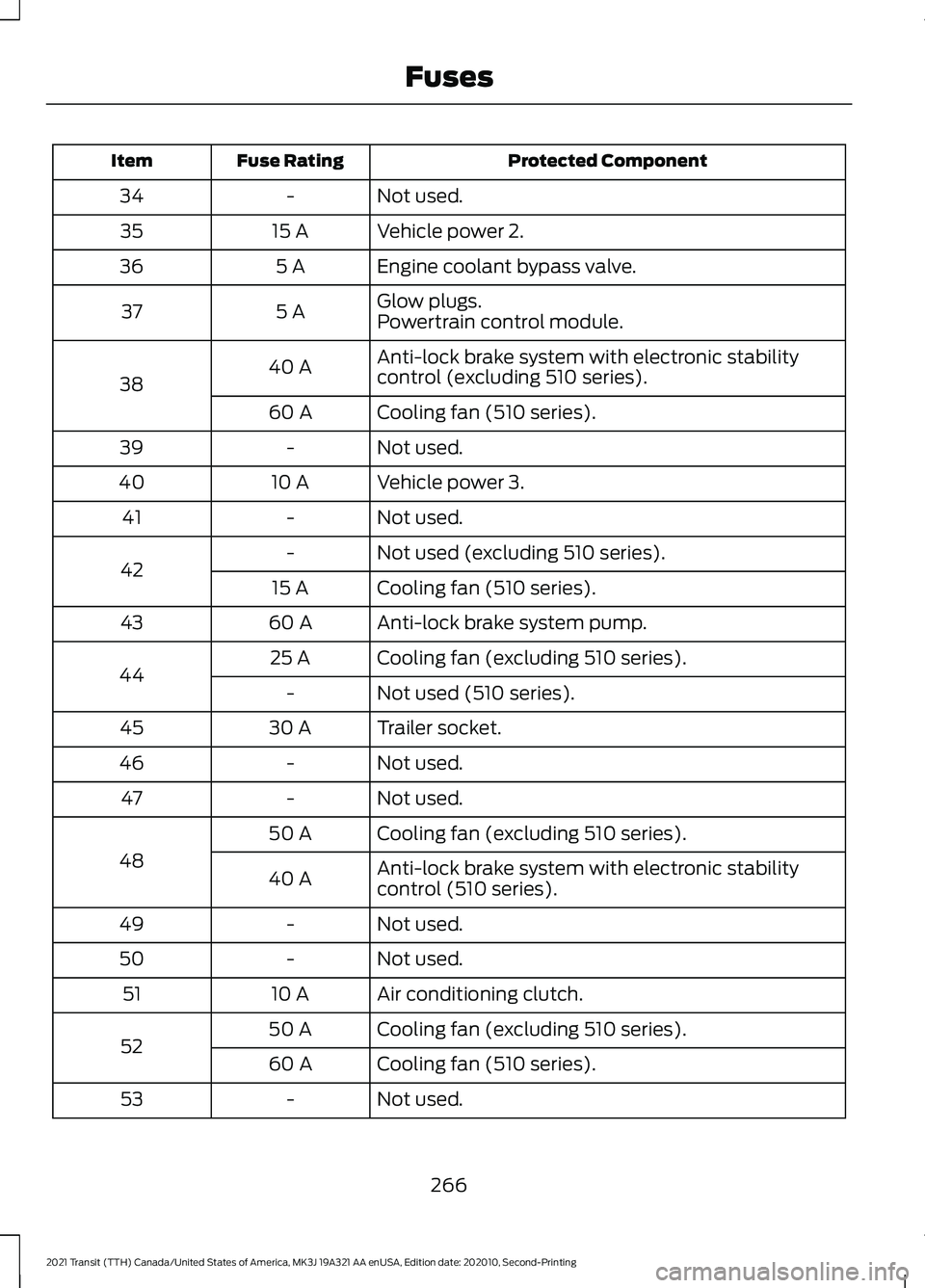
Protected Component
Fuse Rating
Item
Not used.
-
34
Vehicle power 2.
15 A
35
Engine coolant bypass valve.
5 A
36
Glow plugs.
5 A
37
Powertrain control module.
Anti-lock brake system with electronic stability
control (excluding 510 series).
40 A
38
Cooling fan (510 series).
60 A
Not used.
-
39
Vehicle power 3.
10 A
40
Not used.
-
41
Not used (excluding 510 series).
-
42 Cooling fan (510 series).
15 A
Anti-lock brake system pump.
60 A
43
Cooling fan (excluding 510 series).
25 A
44 Not used (510 series).
-
Trailer socket.
30 A
45
Not used.
-
46
Not used.
-
47
Cooling fan (excluding 510 series).
50 A
48 Anti-lock brake system with electronic stability
control (510 series).
40 A
Not used.
-
49
Not used.
-
50
Air conditioning clutch.
10 A
51
Cooling fan (excluding 510 series).
50 A
52 Cooling fan (510 series).
60 A
Not used.
-
53
266
2021 Transit (TTH) Canada/United States of America, MK3J 19A321 AA enUSA, Edition date: 202010, Second-Printing Fuses
Page 283 of 509
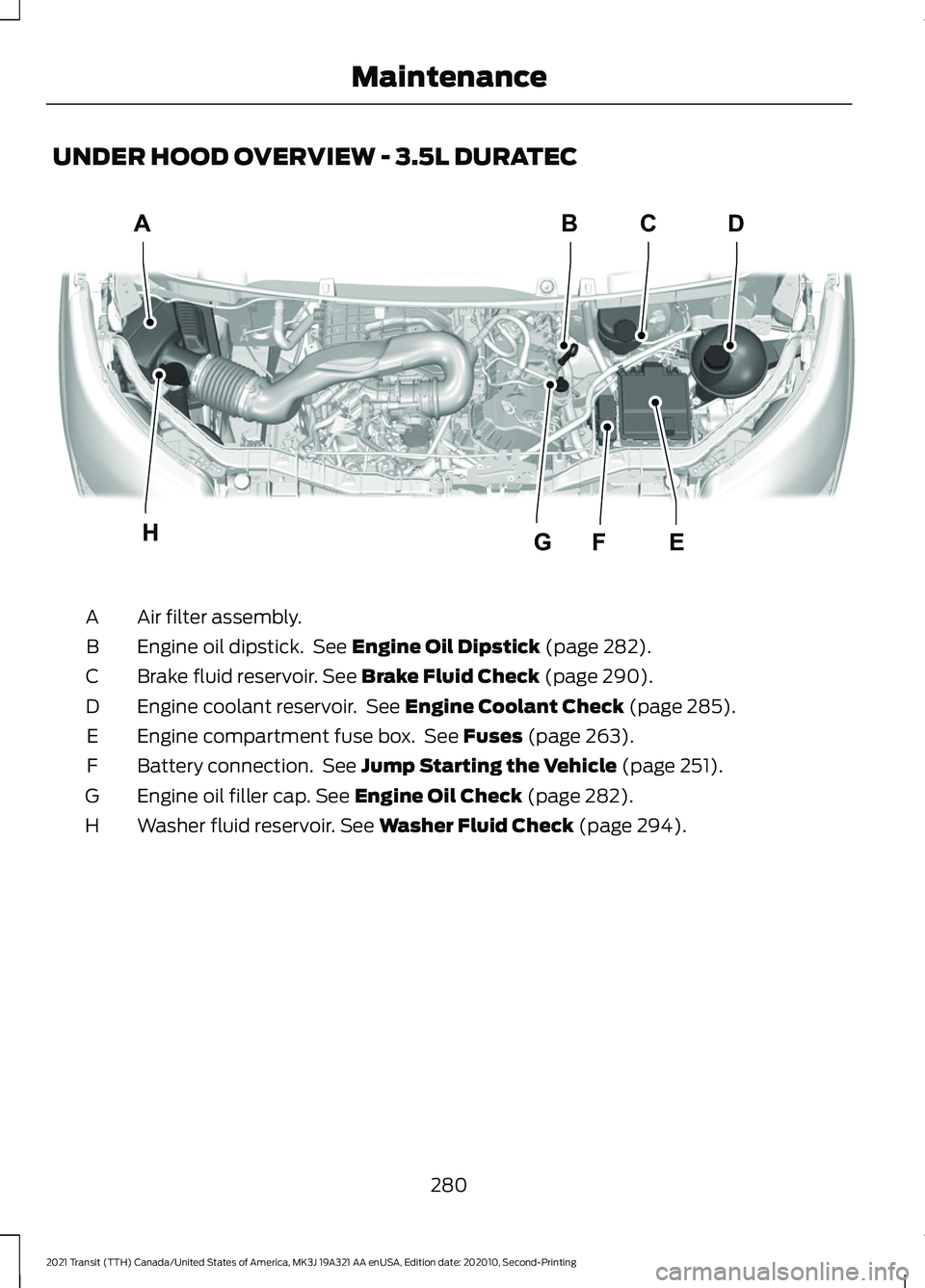
UNDER HOOD OVERVIEW - 3.5L DURATEC
Air filter assembly.
A
Engine oil dipstick. See Engine Oil Dipstick (page 282).
B
Brake fluid reservoir.
See Brake Fluid Check (page 290).
C
Engine coolant reservoir. See
Engine Coolant Check (page 285).
D
Engine compartment fuse box. See
Fuses (page 263).
E
Battery connection. See
Jump Starting the Vehicle (page 251).
F
Engine oil filler cap.
See Engine Oil Check (page 282).
G
Washer fluid reservoir.
See Washer Fluid Check (page 294).
H
280
2021 Transit (TTH) Canada/United States of America, MK3J 19A321 AA enUSA, Edition date: 202010, Second-Printing MaintenanceABDC
EFGHE306489
Page 284 of 509
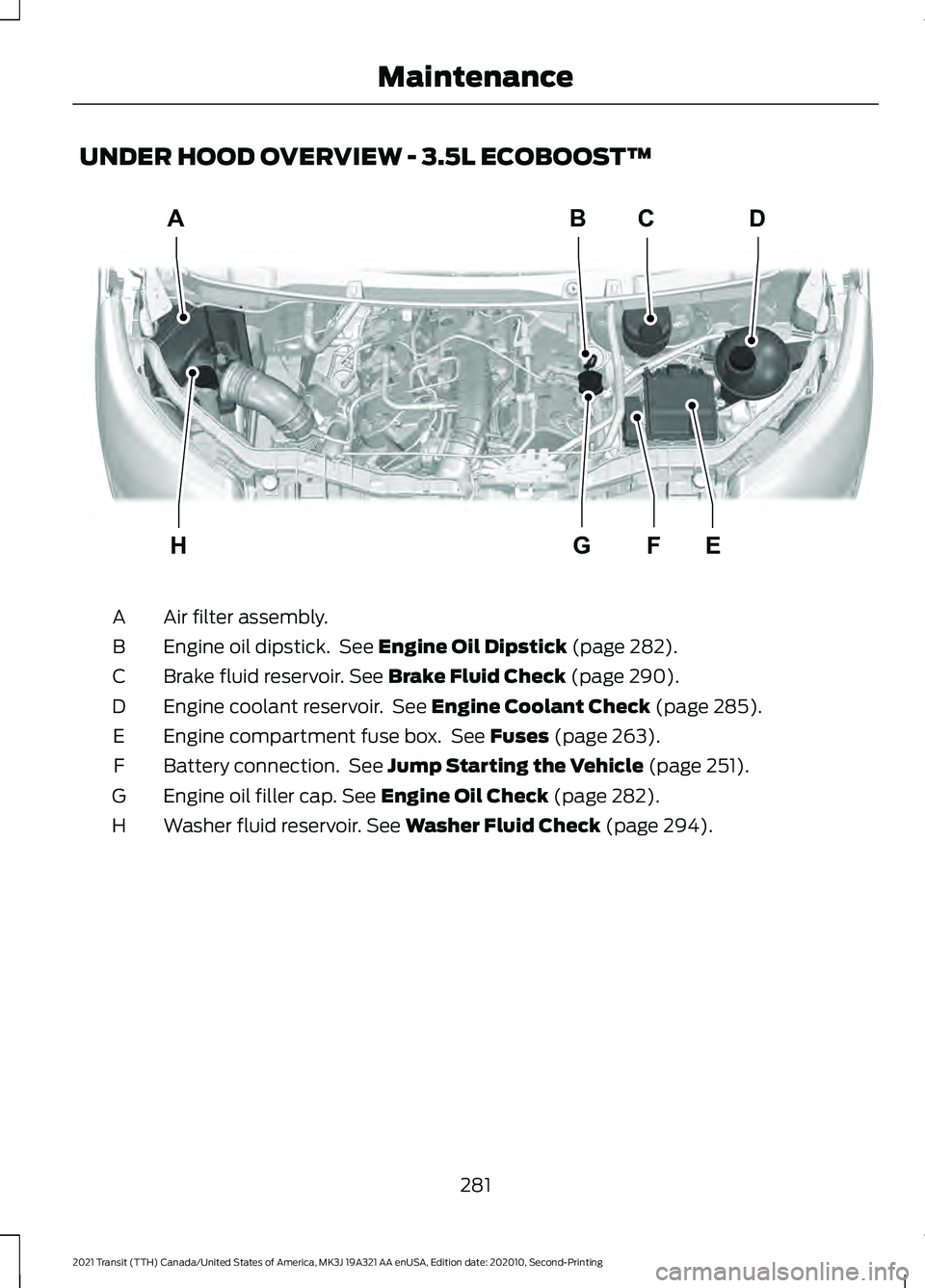
UNDER HOOD OVERVIEW - 3.5L ECOBOOST™
Air filter assembly.
A
Engine oil dipstick. See Engine Oil Dipstick (page 282).
B
Brake fluid reservoir.
See Brake Fluid Check (page 290).
C
Engine coolant reservoir. See
Engine Coolant Check (page 285).
D
Engine compartment fuse box. See
Fuses (page 263).
E
Battery connection. See
Jump Starting the Vehicle (page 251).
F
Engine oil filler cap.
See Engine Oil Check (page 282).
G
Washer fluid reservoir.
See Washer Fluid Check (page 294).
H
281
2021 Transit (TTH) Canada/United States of America, MK3J 19A321 AA enUSA, Edition date: 202010, Second-Printing MaintenanceA
H
BD
EG
C
FE306483